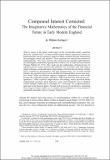Compound Interest Corrected: The Imaginative Mathematics of the Financial Future in Early Modern England
Author(s)
Deringer, William
DownloadPublished version (704.3Kb)
Publisher Policy
Publisher Policy
Article is made available in accordance with the publisher's policy and may be subject to US copyright law. Please refer to the publisher's site for terms of use.
Terms of use
Metadata
Show full item recordAbstract
What is money in the future worth today? In the seventeenth century, questionsabout the“present value”of future wealth became matters of practical concern, asbusinesspeople and governments deployed future-orientedfinancial technologieslike mortgages, bonds, and annuities. Those questions also attracted the attention ofmathematicians. This essay examines the excursions two English mathematicians,the indefatigable mathematical gossip John Collins (1625–83) and the lesser-knownThomas Watkins (fl. 1710s–20s), made into the mathematics offinancial time. Incapitalist practice today, present-value problems are invariably dealt with using asingle technique, compound-interest discounting, which has become deeply embed-ded in commercial, governmental, and legal infrastructures. Yet, for early modernthinkers, the question of how best to calculate thefinancial future was an open ques-tion. Both Collins and Watkins explored imaginative alternatives to what wouldbecome the compound-interest orthodoxy. With help from his network of corre-spondents, Collins explored simple-interest discounting, which provoked thornymathematical questions about harmonic series and hyperbolic curves; Watkinscrafted multiple mathematical techniques for“correcting”the compound-interestapproach to thefinancial future. Though both projects proved abortive, examiningthose forgone futures enables us to examine the development of a key element ofcapitalistic rationality before it became“black-boxed.”
Date issued
2018-10Department
Massachusetts Institute of Technology. Program in Science, Technology and SocietyJournal
Osiris (Bruges, Belgium)
Publisher
University of Chicago Press
Citation
Deringer, William. "Compound Interest Corrected:The Imaginative Mathematics of the FinancialFuture in Early Modern England." Osiris (Bruges, Belgium) 33 (2018): 109-129 © 2019 The Author
Version: Final published version
ISSN
0369-7827
1933-8287